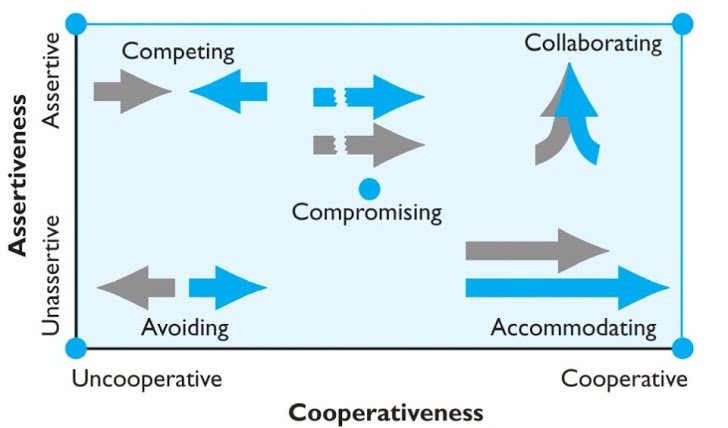Organizational conflict arises when the goals, interests or values of different individuals or groups are incompatible and those individuals or groups block or thwart one another’s attempts to achieve their objective. Conflict Process shows how conflict works within the organization.
We can identify the stages that a conflict born and grows in an organization. In this post, we will look at the stages of a conflict covering the birth, rise, and ending in it.
Five Stages Conflict Process are:
- Potential Opposition or Incompatibility
- Cognition and Personalization
- Intentions
- Behavior
- Outcomes
Conflict Process consists of five stages that show how conflict begins, grows, and unfolds among individuals or groups with different goals, interests or values of the organization.

Stage 1: Potential Opposition or Incompatibility
The first step in the conflict process is the presence of conditions that create opportunities for conflict to develop. These cause or create opportunities for organizational conflict to rise.
They need not lead directly to conflict, but one of these conditions is necessary if the conflict is to surface.
For simplicity’s sake, these conditions have been condensed into three general categories.
- Communication
- Structure
- Personal Variables
These 3 conditions cause conflict are explained;
(a) Communications
Different words connotations, jargon insufficient exchange of information and noise in the communication channel are all antecedent conditions to conflict.
Too much communication, as well as too little communication, can lay the foundation for conflict.
(b) Structure
In this context, the term structure is used to include variables such as size, the degree of specialization in the tasks assigned to group members, jurisdictional clarity, members/goal compatibility, leadership styles, reward systems and the degree of dependence between groups.
The size and specialization act as forces to stimulate conflict. The larger the group and the more specialized its activities, the greater the likelihood of conflict. Tenure and conflict are inversely related.
The potential for conflicts tends to be greatest when group members are younger and when turnover is high.
In defining where responsibility for action lies; the greater the ambiguity is the greater the potential for conflict to the surface. Such Jurisdictional ambiguity increases inter-group fighting for control or resources and territory.
(c) Personal Variables
Certain personality types- for example, individuals who are highly authoritarian and dogmatic- lead to potential conflict. Another reason for the conflict is the difference in value systems.
Value differences are the best explanations of diverse issues such as prejudice disagreements over one’s contribution to the group and rewards one deserves.
Stage 2: Cognition and Personalization
Conflict must be perceived by the parties to it whether or not the conflict exists is a perception issue, the second step of the Conflict Process.
If no one is aware of a conflict, then it is generally agreed that no conflict exists. Because conflict is perceived does not mean that is personalized.
For example
A may be aware that B and A are in serious disagreements but it may not make A tense or nations and it may have no effect whatsoever on A’s affection towards B.
It is the felt level when individuals become emotionally involved that parties experience anxiety, tension or hostility.
Stage-2 is the place in the process where the parties decide what the conflict is about and emotions play a major role in shaping perception.
Stage 3: Intentions
Intentions are decisions to act in a given way, intentions intervene between people’s perception and emotions and their overt behavior.
Using two dimensions cooperativeness (the degree to which one party attempts to satisfy the other party’s concerns) and assertiveness (the degree to which one party attempts to satisfy his or her concerns) five conflict-handling intentions can be identified.

5 Conflict-Handling Intention
There are 5 conflict-handling intentions:
- Competing (I Win, You Lose)
- Collaborating (I Win, You Win)
- Avoiding (No Winners, No Losers)
- Accommodating (I lose, You win)
- Compromising (You Bend, I Bend)
Stage 4: Behavior
This is a stage where conflict becomes visible. The behavior stage includes the statements, actions, and reactions made by the conflicting parties.
These conflict behaviors are usually overt attempts to implement each party’s intentions.
When most people think of conflict situations, they tend to focus on Stage 4.
Why?
Because this is a stage Where conflict becomes visible. The behavior stage includes the statements, actions, and reactions made by the conflicting parties;
These conflict behaviors are usually overt attempts to implement each party’s intentions. But these behaviors have a stimulus quality that is separate from intentions.
As a result of miscalculations or unskilled enactments, overt behaviors sometimes deviate from original intentions.
It helps to think of stage 4 as a dynamic process of interaction.
Stage 5: Outcomes
The action-reaction interplay between the conflicting parties results in consequences.
These outcomes may be functional in that the conflict results in an improvement in the group’s performance, or dysfunctional in that it hinders group performance.
Conflict is constructive when it improves the quality of decisions that stimulates creativity and innovations encourage interest and curiosity among group members to provide the medium through which problems can be aired and tensions released and foster an environment of self-evaluation and change.
Conflict is dysfunctional when uncontrolled opposition breeds discontent, which acts to dissolve common ties and eventually leads to the destruction of the group.
Among the more undesirable consequences are a retarding of communication, reductions in group cohesiveness and subordination of group goals to the primacy of infighting between members.